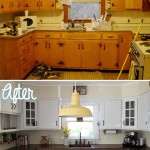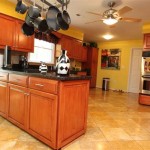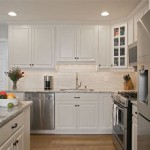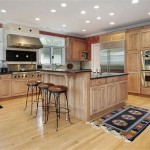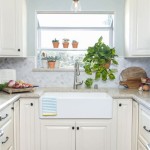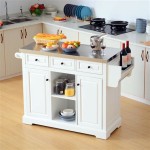Photos of Kitchens with Oak Cabinets: Exploring Timeless Design and Modern Updates
Oak cabinets have held a prominent position in kitchen design for decades. Their inherent warmth, durability, and natural grain patterns contribute to a comfortable and inviting atmosphere. While oak may be perceived as a dated choice by some, a wealth of design possibilities exist to modernize and revitalize kitchens featuring these classic cabinets. Examining photos of kitchens with oak cabinets reveals a range of styles and approaches, demonstrating their enduring appeal and adaptability. This article explores various design strategies and considerations to help homeowners maximize the potential of their oak kitchen.
Understanding the Appeal of Oak Cabinets
The enduring popularity of oak cabinets stems from several key attributes. First, oak is a naturally strong and resilient hardwood, capable of withstanding daily wear and tear in a busy kitchen environment. This durability translates into long-lasting cabinetry that can provide years of reliable service. Second, the distinctive grain pattern of oak wood offers visual interest and texture, adding depth and character to the overall design. Different oak varieties, such as red oak and white oak, present variations in color and grain, providing homeowners with a range of aesthetic choices. Lastly, oak's natural warm tones, typically ranging from honey to amber, contribute to a welcoming and comfortable feeling, making it well-suited for the heart of the home.
However, the very characteristics that make oak appealing can also present design challenges. The strong grain pattern can sometimes appear busy or overwhelming, particularly in smaller kitchens. The warm tones, while inviting, may clash with certain color palettes or design styles if not carefully considered. As a result, thoughtful planning and design execution are crucial to achieving a cohesive and visually appealing kitchen with oak cabinets.
Many homeowners inherit oak kitchens from previous owners or find themselves in situations where replacing existing cabinetry is not feasible. In these cases, understanding how to work with and enhance the existing oak cabinets becomes paramount. Instead of viewing oak as a limitation, homeowners can explore creative avenues to transform their kitchens into stylish and functional spaces.
Modernizing Oak Cabinets: Paint, Stain, and Hardware
One of the most impactful transformations for oak cabinets involves altering their color. Painting oak cabinets can drastically change the overall aesthetic of the kitchen, offering virtually limitless color possibilities. Opting for lighter shades, such as white, off-white, or light gray, can instantly brighten the space and create a more contemporary feel. These lighter colors also tend to minimize the visibility of the oak grain, creating a smoother and more uniform appearance. When painting oak, proper preparation is essential. This includes thorough cleaning, sanding to create a suitable surface for adhesion, and priming to ensure even coverage and long-lasting results. Choosing a high-quality paint specifically formulated for cabinets is also crucial for durability and resistance to chipping and scratching.
Staining offers another way to update oak cabinets while preserving the natural wood grain. Choosing a darker stain, such as a deep brown or espresso, can create a more sophisticated and dramatic look. Alternatively, a lighter stain can enhance the natural warmth of the oak while toning down any overly orange or yellow undertones. When staining, it is important to remove any existing finish and apply the stain evenly, following the manufacturer's instructions carefully. A protective topcoat will help to seal the stain and provide added durability.
Replacing the hardware on oak cabinets is a relatively inexpensive and simple way to update their appearance. Swapping out outdated knobs and pulls for more modern styles can significantly enhance the overall aesthetic. Consider sleek, minimalist hardware in finishes such as brushed nickel, stainless steel, or matte black for a contemporary look. Alternatively, antique or vintage-inspired hardware can add a touch of character and charm to a more traditional oak kitchen. When choosing hardware, consider the overall style of the kitchen and select pieces that complement the cabinetry and other design elements.
Beyond paint, stain, and hardware, other modifications can further enhance the appearance of oak cabinets. Adding glass-front doors to some of the upper cabinets can break up the monotony of solid wood and create visual interest. This is an excellent way to display decorative items or glassware, adding a personal touch to the kitchen. Installing under-cabinet lighting can also highlight the texture and color of the oak, creating a warm and inviting ambiance.
Complementary Design Elements: Countertops, Backsplashes, and Flooring
The choice of countertops, backsplashes, and flooring plays a crucial role in creating a harmonious and balanced kitchen design with oak cabinets. Selecting materials and colors that complement the oak's warm tones is essential for achieving a cohesive look. Countertops that contrast well with oak include granite, quartz, and butcher block. Lighter-colored countertops, such as white or cream-colored quartz, can brighten the space and create a more modern feel. Darker countertops, such as black granite or soapstone, can add a touch of sophistication and drama. Butcher block countertops offer a warm and natural complement to oak cabinets, creating a rustic or farmhouse-inspired aesthetic.
The backsplash provides an opportunity to introduce color, texture, and pattern into the kitchen. Subway tiles in white, cream, or light gray are classic choices that work well with oak cabinets. Glass tiles in various colors can add a touch of shimmer and elegance. Mosaic tiles offer a chance to incorporate intricate patterns and designs. When choosing a backsplash, consider the overall color scheme of the kitchen and select tiles that complement the oak cabinetry and countertops. Avoid backsplashes with overly busy patterns, as they can compete with the natural grain of the oak.
Flooring choices can significantly impact the overall feel of the kitchen. Hardwood flooring in a complementary tone is a natural choice for oak cabinets. Lighter wood floors can brighten the space, while darker wood floors can create a more dramatic look. Tile flooring is another durable and versatile option. Neutral-colored tiles, such as beige, gray, or off-white, can provide a solid foundation for the kitchen design. Consider using area rugs to add warmth, color, and texture to the floor. Choose rugs that complement the cabinetry and other design elements, and be sure to select rugs that are durable and easy to clean.
Lighting is also a critical aspect of kitchen design that can significantly impact the appearance of oak cabinets. Adequate lighting is essential for both functionality and aesthetics. Consider incorporating a combination of ambient, task, and accent lighting to create a well-lit and inviting space. Under-cabinet lighting can highlight the texture and color of the oak, while pendant lights over the island or peninsula can add a touch of style and sophistication. Recessed lighting can provide general illumination, while track lighting can be used to highlight specific areas of the kitchen.
Color Palette Considerations for Oak Kitchens
Selecting the right color palette is crucial for creating a visually appealing and harmonious kitchen with oak cabinets. The warm tones of oak can work well with a variety of colors, but careful consideration is needed to avoid clashes or an outdated look. Neutral colors, such as white, cream, gray, and beige, are generally safe and versatile choices that can create a clean and modern aesthetic. These colors can be used on walls, countertops, backsplashes, and flooring to create a balanced and cohesive design. Adding pops of color through accessories, such as dishware, artwork, and textiles, can add personality and visual interest.
Cool colors, such as blue, green, and purple, can also work well with oak cabinets, but it is important to choose the right shades. Muted or earthy tones of these colors tend to complement oak better than bright or saturated hues. For example, a soft olive green or a dusty blue can create a calming and inviting atmosphere. Avoid using overly cool colors, such as icy blues or stark whites, as they can clash with the warmth of the oak.
Warm colors, such as red, orange, and yellow, can also be used in oak kitchens, but they should be used sparingly and carefully. These colors can easily overpower the space and create an overly warm or dated look. Consider using warm colors as accents, such as in the backsplash, artwork, or accessories. A touch of terracotta or a splash of golden yellow can add warmth and vibrancy without overwhelming the overall design.
Ultimately, the best color palette for an oak kitchen will depend on the homeowner's personal preferences and the overall style of the kitchen. Experimenting with different color combinations and considering the lighting and other design elements is essential for creating a space that is both visually appealing and functional.

Top 20 Kitchen Countertop Ideas With Oak Cabinets Marble Systems

10 Oak Kitchen Ideas For Every Home 2025 Checkatrade

How To Make Oak Kitchen Cabinets Look Modern An Overview

Top 20 Kitchen Countertop Ideas With Oak Cabinets Marble Systems

How To Make Oak Kitchen Cabinets Look Modern Without Covering Them Up
:max_bytes(150000):strip_icc()/DesignbyNatalieKraiemPhotobyKirstenFrancis-c8c60d48cd3541a9bdb756a933aa3780-a21edbeb7f374a498dd8a5cfbb33cdd1.jpg?strip=all)
25 Kitchens With Light Wood Cabinets Sure To Impress

Updating A Kitchen With Oak Cabinets Without Painting Them

Amazing Countertop Colors For Honey Oak Cabinets West Magnolia Charm

Oak Kitchen Cabinets In Stock Shop Online Free Shipping

Diy Painted Oak Kitchen Cabinets Makeover

